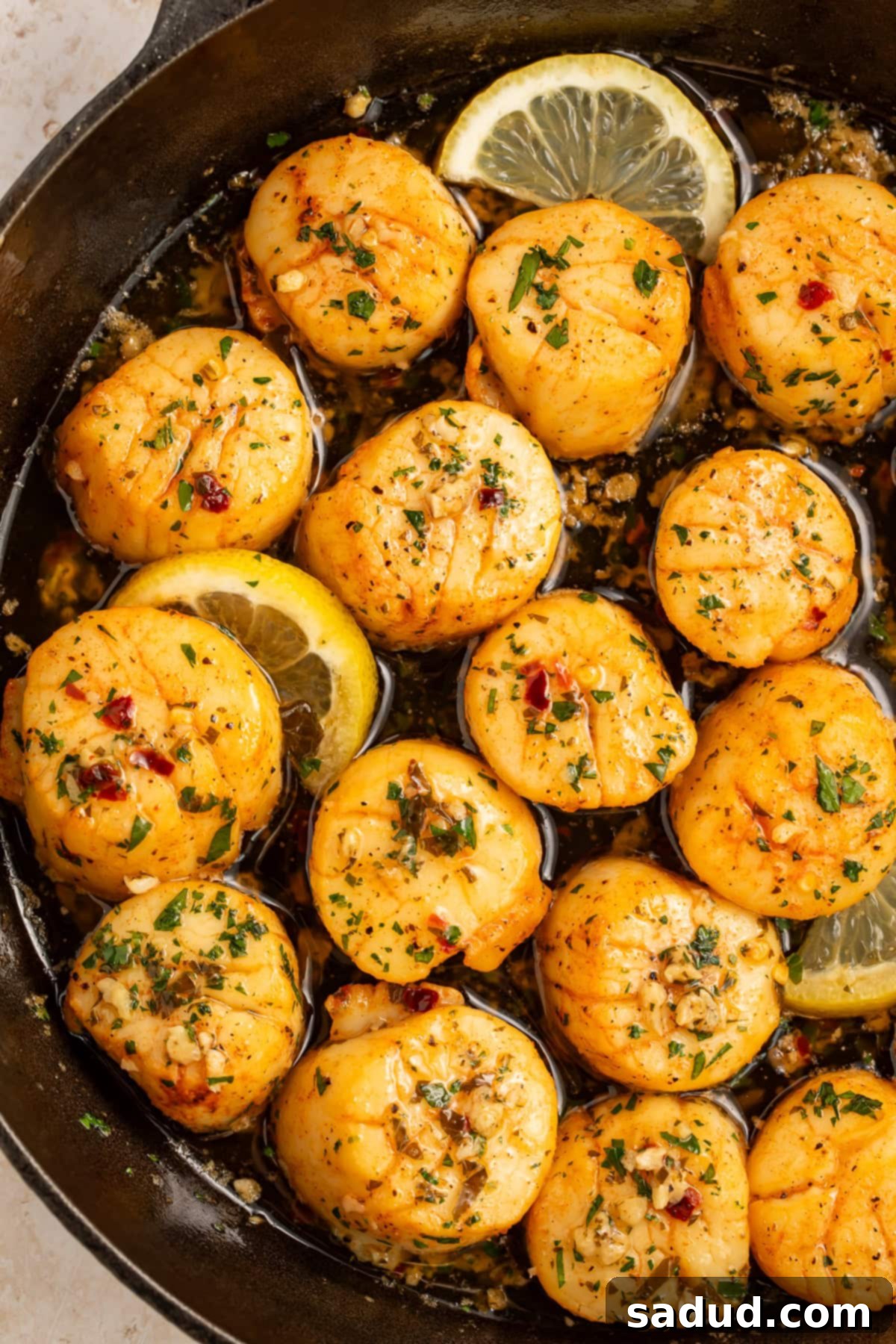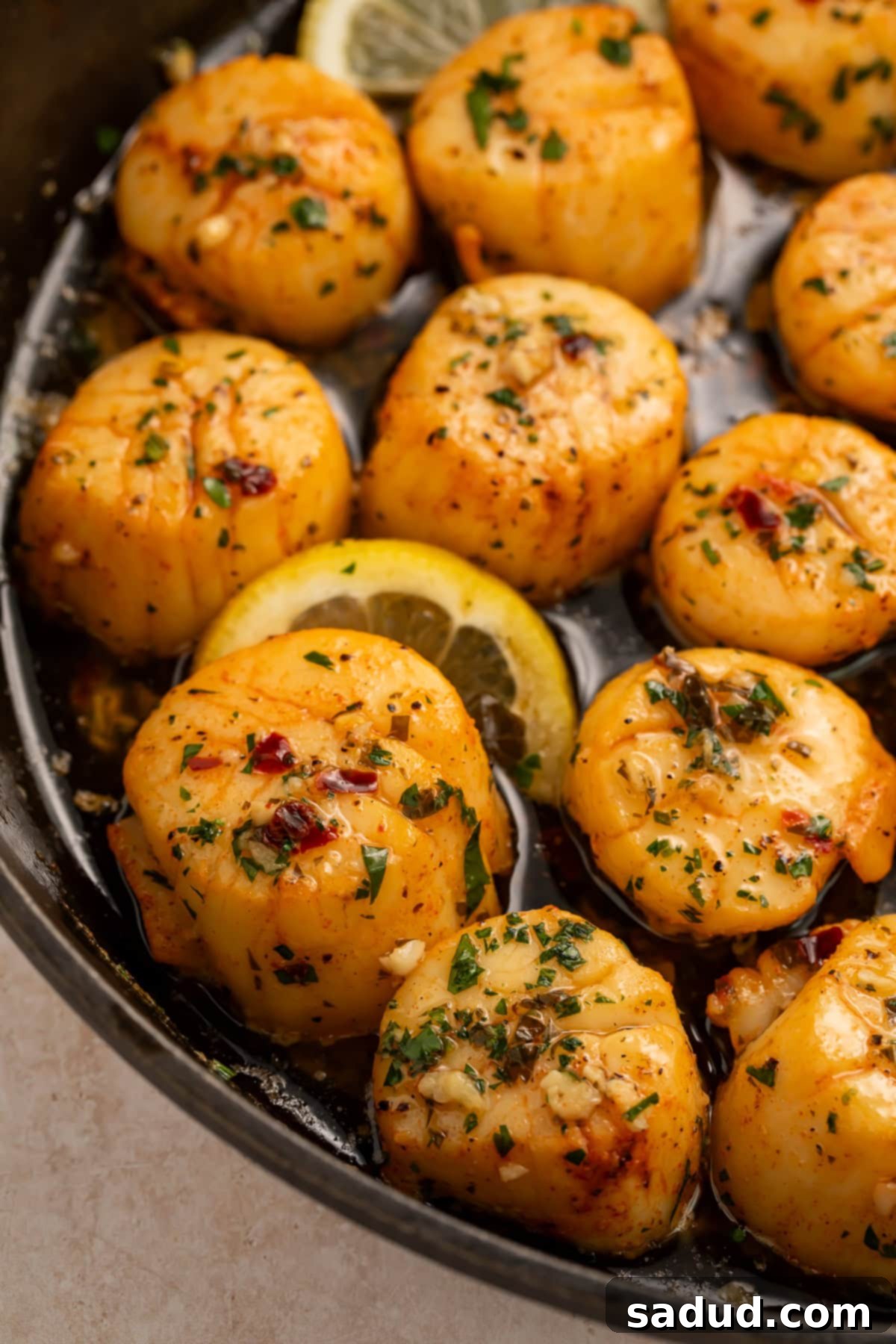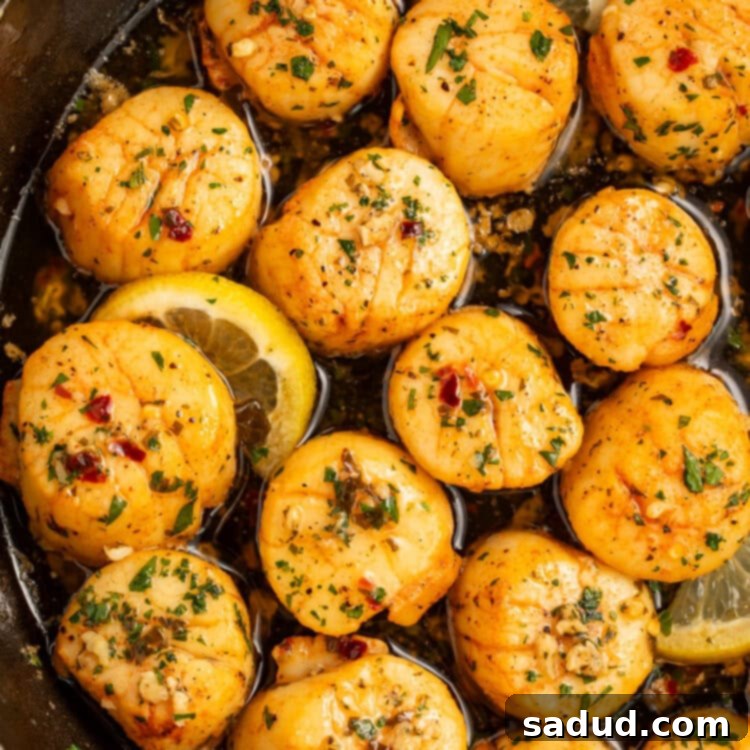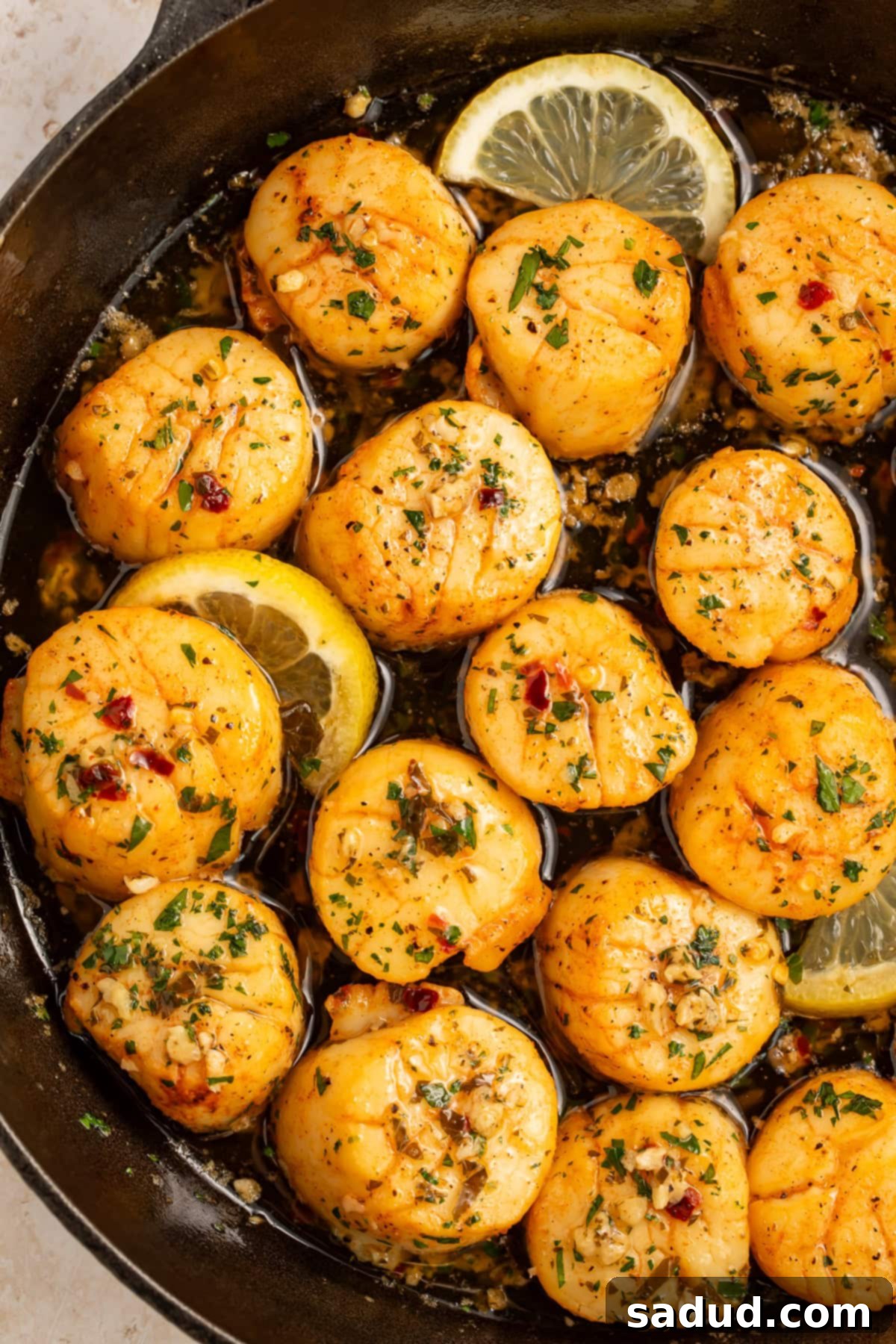Easy Smoked Scallops Recipe: Perfect for Beginners with Citrus Garlic Butter
Embark on a culinary adventure with these incredibly simple yet profoundly flavorful Smoked Scallops. This recipe is an absolute dream for anyone new to smoking, offering a straightforward path to perfectly tender, smoky scallops without any fuss. Paired with an irresistible citrus garlic butter, these smoked scallops transform into a versatile dish that can elevate any meal. Whether you’re planning a light and elegant dinner alongside fresh greens, a decadent topping for creamy risotto, or a sophisticated appetizer served with crusty baguette, these smoked beauties are guaranteed to impress. Prepare for a dish that’s easy to make, yet tastes like it came straight from a gourmet kitchen!

Why You’ll Love This Smoked Scallops Recipe
- Effortlessly Beginner-Friendly Smoking: If you’re new to the exciting world of food smoking, this recipe is your ideal starting point. With a basic smoker setup and a mere 1 hour of smoking time, you’ll achieve fantastic, restaurant-quality results. Scallops are forgiving and cook relatively quickly, making them less intimidating than larger cuts of meat, ensuring a successful and rewarding first smoking experience. You’ll build confidence in your smoking skills while enjoying a delicious meal.
- Unforgettable Citrus Garlic Butter: The secret weapon in this dish is the vibrant and zesty citrus garlic butter. It infuses the delicate scallops with an incredible burst of fresh flavor – bright lemon, pungent garlic, and a hint of spice from optional red pepper flakes create an “addictive” sauce that perfectly complements the smoky seafood. This butter isn’t just for serving; it’s a key component that brings moisture and a fantastic aroma to every bite. While you can use your favorite pre-made compound butter that pairs well with seafood, we highly recommend trying this homemade version for its unparalleled fresh zest and depth.
- Incredibly Versatile Serving Options: These Smoked Scallops are truly adaptable to any occasion and dining preference. Serve them as a sophisticated appetizer with toasted baguette slices, perfect for soaking up every last drop of the flavorful butter, or as a luxurious main course. They shine when paired with simple sides like grilled asparagus or broccolini for a light and healthy meal. For a richer, more comforting experience, spoon them generously over a warm, creamy risotto, allowing the butter to meld beautifully with the rice. If you’re celebrating a special occasion, consider pairing these exquisite scallops with a crisp Sauvignon Blanc or a refreshing Albariño to enhance the seafood’s natural sweetness and the butter’s bright notes.
- Healthy and Lean Protein Powerhouse: Beyond their incredible taste, scallops are an excellent source of lean protein, low in fat, and packed with essential minerals such as selenium, zinc, and Vitamin B12. Smoking them gently preserves their delicate texture and nutritional benefits, making this a delicious, wholesome, and guilt-free meal option that supports a healthy lifestyle.
Mastering Smoked Scallops: Chef’s Essential Tips for Success
- Precision Cooking with an Instant-Read Thermometer is Key: Scallops are notoriously easy to overcook, which can quickly transform their tender, succulent texture into something rubbery and unappeappetizing. However, with an instant-read thermometer, it’s almost impossible to go wrong. Simply insert the thermometer into the thickest part of a scallop to get an accurate reading. This simple, indispensable tool is your best friend for achieving perfectly tender and juicy results every time.
- The Ideal Internal Temperature for Succulent Scallops: For the most tender and melt-in-your-mouth smoked scallops, aim for an internal cooked temperature between 120°F-130°F (49°C-54°C). This temperature range is slightly lower than the generally recommended 145°F (63°C) for cooked seafood, which often results in scallops that are just past their prime and slightly overcooked. The lower target temperature ensures a delicate, almost creamy texture that truly highlights their natural sweetness. Remember that scallops will continue to cook slightly after being removed from the smoker due to carryover heat.
- The Critical Step: Patting Scallops Dry: Before you even think about seasoning or placing them in the smoker, it is absolutely crucial to pat your scallops thoroughly dry with paper towels. Excess moisture on the surface of the scallops not only hinders proper smoke absorption but also prevents them from developing a desirable texture. Dry scallops will absorb more of that wonderful smoky flavor and cook more evenly, leading to a superior finished product. This step cannot be emphasized enough for perfect results.
- Choosing the Right Smoking Wood for Delicate Flavor: The type of wood you use for smoking will significantly impact the flavor profile of your smoked scallops. For delicate seafood like scallops, opt for mild, fruity woods such as apple, alder, or cherry. These woods impart a gentle, sweet smoke that enhances the scallops’ natural flavor without overpowering their subtle taste. Avoid strong, heavy woods like mesquite or hickory, which can be far too aggressive and mask the delicate flavors of the seafood.
Selecting and Preparing Your Scallops for Optimal Smoking
The quality and initial preparation of your scallops are paramount to achieving a truly exceptional smoked dish. Understanding the different types and how to handle them will make all the difference.
Dry-Packed vs. Wet-Packed Scallops: What’s the Difference?
When you’re at the seafood counter, you’ll typically encounter two main types of scallops: dry-packed and wet-packed. Knowing the distinction is crucial for this recipe:
- Dry-Packed Scallops: These are scallops that have been harvested and then either flash-frozen or refrigerated without any added chemicals or solutions. They usually appear cream-colored to slightly pinkish and boast a naturally sweet, pure scallop flavor. Critically, dry-packed scallops contain very little excess moisture, which is incredibly important for smoking as it allows for better smoke penetration and helps achieve that superior, tender texture without becoming rubbery. We highly recommend seeking out dry-packed scallops for this recipe for the best possible results.
- Wet-Packed Scallops: These scallops are commonly soaked in a solution of sodium tripolyphosphate (STP). This chemical is used to preserve them and, unfortunately, to increase their shelf life and weight by causing them to absorb water. While they may appear whiter and plumper, wet-packed scallops often have a slightly soapy or metallic flavor and a rubbery texture once cooked. The added moisture also makes it challenging for them to absorb smoke flavor effectively and can lead to a less desirable end product. If dry-packed scallops are unavailable, make sure to rinse wet-packed scallops thoroughly under cold water and pat them *extra dry* before seasoning and smoking to mitigate some of these issues.
Choosing the Right Size of Scallops
For smoking, larger sea scallops are generally preferred over smaller bay scallops. Their size offers several advantages: they are easier to handle on the smoker, they provide a good surface area for uniform smoke absorption, and they are less prone to drying out too quickly during the smoking process. Aim for “U/10” (meaning under 10 scallops per pound) or “U/15” scallops for ideal smoking results. These larger sizes ensure a more substantial and satisfying bite after cooking.
Prepping Your Scallops
Beyond choosing dry-packed and patting them dry, ensure any small, tough “side muscle” (adductor muscle) is removed from each scallop. This muscle is typically on the side and looks like a small, rectangular tag. It can be chewy if left on, so simply pinch it off with your fingers before seasoning.
Frequently Asked Questions About Smoked Scallops
Yes, absolutely! Scallop roe (the orange or white crescent-shaped part attached to the muscle) is considered a delicacy in many parts of the world and is perfectly safe and delicious to eat. While not everyone is a fan of the texture or slightly stronger taste, if they’re still attached to your scallops, they will smoke beautifully along with the main muscle and can add another layer of unique flavor to your dish. You can always remove them after cooking if you find you don’t care for them, but we encourage you to try them at least once!
Yes, this is a fantastic time-saving tip that we highly recommend! You can prepare the citrus garlic butter up to 3 days in advance and store it in an airtight container in the refrigerator. For even longer storage, it can be kept in the freezer for up to a month. When you’re ready to serve, simply reheat the butter gently in a small saucepan over low heat until it’s warmed through and fragrant. This butter is also incredibly versatile; consider making extra to serve with grilled fish, pan-seared shrimp, steamed crab legs, or even tossed with steamed vegetables for an extra flavor boost.
Almost any type of smoker can be used effectively for scallops, as long as it can maintain a low, consistent temperature (around 225°F or 107°C) for the duration of the cooking time. Popular choices include pellet grills, electric smokers, and even traditional charcoal grills equipped with a smoking box or tube for wood chips. The key to success is consistent temperature control and, as mentioned in our tips, selecting a mild wood type to avoid overpowering the delicate flavor of the scallops. Don’t feel you need a fancy setup to achieve fantastic smoked scallops!
If you’re lucky enough to have any leftover smoked scallops (they tend to disappear quickly!), store them promptly in an airtight container in the refrigerator for up to 2-3 days. To reheat, the goal is to warm them gently without overcooking. You can do this by warming them in a skillet over very low heat with a little extra butter or olive oil, or in a preheated oven at 250°F (120°C) until just warmed through. Avoid high heat or long reheating times, as this can quickly make the scallops tough and rubbery.

More Delicious Seafood Recipes You’ll Love
- Medium Rare Air Fryer Salmon (in 10 minutes!)
- Tuna Carpaccio with Avocado
- Easy Creamy Seafood Chili
- Creole Seafood Jambalaya
- Easy Homemade Teriyaki Shrimp
- Ahi Tuna Ceviche Recipe
If you loved this recipe as much as we did, don’t forget to leave us a review below. ★ Follow Easy Healthy Recipes on Pinterest, Facebook, and Instagram, too!
For more delicious recipes, visit our sister sites, 40 Aprons and Easy Cheap Recipes.

Smoked Scallops
 Cheryl Malik
Cheryl Malik
Print
SaveSaved!
Ingredients
For the Scallops
- 2-1 ½ lbs large sea scallops dry-packed preferred
- 1 tbsp olive oil
- 1 tsp salt
- 1 tsp lemon zest
- ½ tsp black pepper
- ½ tsp paprika optional for extra color/flavor
For the Citrus Garlic Butter
- ½ cup unsalted butter 1 stick
- 3 cloves garlic minced
- 1 tbsp lemon juice
- ½ tsp crushed red pepper flakes optional
- 1 tbsp chopped parsley plus extra for garnish
Equipment
-
smoker
-
mild wood like apple, alder, or cherry
-
Wire rack
Instructions
Smoke the Scallops
-
Pat the scallops very dry with paper towels (this is crucial for good texture and smoke absorption).
-
In a bowl, toss the scallops with olive oil, salt, pepper, smoked paprika, and lemon zest. Let sit while you prep your smoker.
-
Set your smoker to 225°F. Use a mild wood like apple, alder, or cherry for a delicate smoke that won’t overpower the scallops.
-
Place scallops directly on a lightly greased wire rack or perforated pan to allow smoke to circulate. Smoke for 45-60m, until they are opaque and just firm to the touch (internal temp should be 120–130°F for tender scallops). Don’t overcook!
Make the Butter
-
While the scallops are smoking, in a small saucepan over medium-low heat, melt the butter.
-
Add the garlic and sauté for about 1 minute until fragrant.
-
Stir in lemon juice, red pepper flakes (if using), and parsley. Simmer gently for 2–3 minutes, then keep warm.
Finish & Serve
-
Once scallops are done, plate them and spoon warm citrus garlic butter over the top. Garnish with extra parsley and a squeeze of fresh lemon if desired.
Notes
Nutrition Information
Number of total servings shown is approximate. Actual number of servings will depend on your preferred portion sizes.
Nutritional values shown are general guidelines and reflect information for 1 serving using the ingredients listed, not including any optional ingredients. Actual macros may vary slightly depending on specific brands and types of ingredients used.
To determine the weight of one serving, prepare the recipe as instructed. Weigh the finished recipe, then divide the weight of the finished recipe (not including the weight of the container the food is in) by the desired number of servings. Result will be the weight of one serving.
